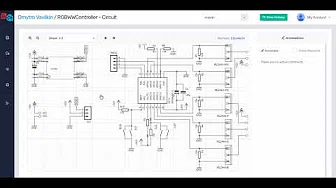Files
Scanning the repository...
Last update 6 years 8 months
by Emanuele Giacomini
| FilesrefTUTTO PIXYexamplesccc_zumo_chase | |
|---|---|
| .. | |
| ccc_zumo_chase.ino |
ccc_zumo_chase.ino// // begin license header // // This file is part of Pixy CMUcam5 or "Pixy" for short // // All Pixy source code is provided under the terms of the // GNU General Public License v2 (http://www.gnu.org/licenses/gpl-2.0.html). // Those wishing to use Pixy source code, software and/or // technologies under different licensing terms should contact us at // cmucam@cs.cmu.edu. Such licensing terms are available for // all portions of the Pixy codebase presented here. // // end license header // #include <Pixy2.h> #include <PIDLoop.h> #include <ZumoMotors.h> // this limits how fast Zumo travels forward (400 is max possible for Zumo) #define MAX_TRANSLATE_VELOCITY 250 Pixy2 pixy; ZumoMotors motors; PIDLoop panLoop(350, 0, 600, true); PIDLoop tiltLoop(500, 0, 700, true); PIDLoop rotateLoop(300, 600, 300, false); PIDLoop translateLoop(400, 800, 300, false); void setup() { Serial.begin(115200); Serial.print("Starting...\n"); // initialize motor objects motors.setLeftSpeed(0); motors.setRightSpeed(0); // need to initialize pixy object pixy.init(); // user color connected components program pixy.changeProg("color_connected_components"); } // Take the biggest block (blocks[0]) that's been around for at least 30 frames (1/2 second) // and return its index, otherwise return -1 int16_t acquireBlock() { if (pixy.ccc.numBlocks && pixy.ccc.blocks[0].m_age>30) return pixy.ccc.blocks[0].m_index; return -1; } // Find the block with the given index. In other words, find the same object in the current // frame -- not the biggest object, but he object we've locked onto in acquireBlock() // If it's not in the current frame, return NULL Block *trackBlock(uint8_t index) { uint8_t i; for (i=0; i<pixy.ccc.numBlocks; i++) { if (index==pixy.ccc.blocks[i].m_index) return &pixy.ccc.blocks[i]; } return NULL; } void loop() { static int16_t index = -1; int32_t panOffset, tiltOffset, headingOffset, left, right; Block *block=NULL; pixy.ccc.getBlocks(); if (index==-1) // search.... { Serial.println("Searching for block..."); index = acquireBlock(); if (index>=0) Serial.println("Found block!"); } // If we've found a block, find it, track it if (index>=0) block = trackBlock(index); // If we're able to track it, move motors if (block) { // calculate pan and tilt errors panOffset = (int32_t)pixy.frameWidth/2 - (int32_t)block->m_x; tiltOffset = (int32_t)block->m_y - (int32_t)pixy.frameHeight/2; // calculate how to move pan and tilt servos panLoop.update(panOffset); tiltLoop.update(tiltOffset); // move servos pixy.setServos(panLoop.m_command, tiltLoop.m_command); // calculate translate and rotate errors panOffset += panLoop.m_command - PIXY_RCS_CENTER_POS; tiltOffset += tiltLoop.m_command - PIXY_RCS_CENTER_POS - PIXY_RCS_CENTER_POS/2 + PIXY_RCS_CENTER_POS/8; rotateLoop.update(panOffset); translateLoop.update(-tiltOffset); // keep translation velocity below maximum if (translateLoop.m_command>MAX_TRANSLATE_VELOCITY) translateLoop.m_command = MAX_TRANSLATE_VELOCITY; // calculate left and right wheel velocities based on rotation and translation velocities left = -rotateLoop.m_command + translateLoop.m_command; right = rotateLoop.m_command + translateLoop.m_command; // set wheel velocities motors.setLeftSpeed(left); motors.setRightSpeed(right); // print the block we're tracking -- wait until end of loop to reduce latency block->print(); } else // no object detected, stop motors, go into search state { rotateLoop.reset(); translateLoop.reset(); motors.setLeftSpeed(0); motors.setRightSpeed(0); index = -1; // set search state } }








